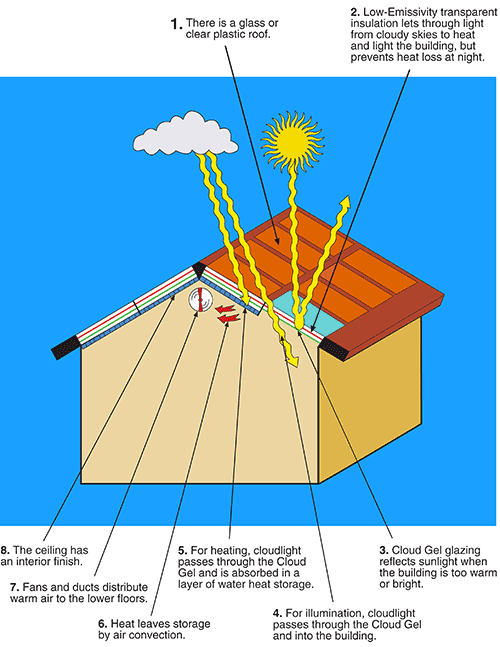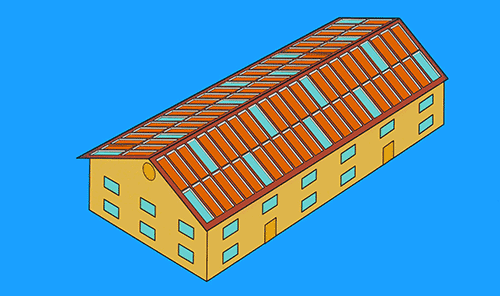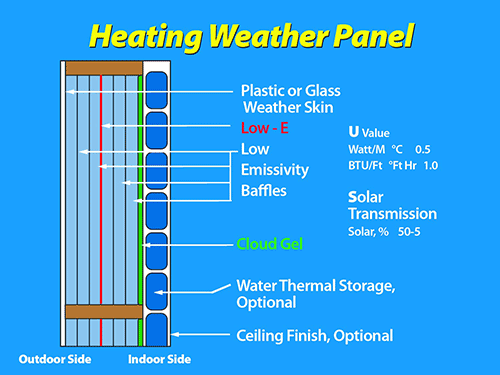Today, solar energy is synonymous with solar electric panels. But there is also a simpler and much cheaper way to use the sun’s energy. Designing the molecules and electrons in a roof to capture and control solar heat can supply one-sixth of the world’s energy, as was shown in field tests by the European Union.
- - This roof has zero impact on building design
— making solar heating practical at last.
- - Cost is the same as traditional roofing, so the
heat is free.
- - This simple technology is much easier to implement than all other clean energy technologies — which are neither simple nor free.
Low-Emissivity is an invisible silver coating only 100 atoms
thick. The vibration of its electrons are tuned to make
windows that insulate like walls and solar collectors that heat
buildings with only cloudlight — even in freezing weather!
Because Low-E costs only $0.03 per square foot, enough Low-E coated
windows have been made to cover Rhode Island. Low-E is
saving $200 billion per year for heating and cooling, and
3.7% of world
energy — many times solar electricity. Low-E was
developed, manufactured, and marketed with only $6 million, making
Suntek the most effective clean energy organization.
Cloud Gel is another glazing material designed by Suntek. It
transmits sunlight when it is cool and heat is needed. But
when heated only one degree, its molecules change shape and turn
white. This reflects away sunlight when a room is too
warm, working like a thermostat. The Cloud Gel factory can
produce 10 million square feet per year.
Weather Panels are roof panels made with Low-E to collect solar heat and Cloud Gel to control it, with a thin layer of water to store heat overnight. The only moving parts are carefully designed molecules and electrons. To build a roof, these factory-made panels are simply bolted onto a steel frame. Air ducts distribute the heat. Field tests show that these roofs reduce heating costs by 85% — even in the cold, cloudy climates where most heating energy is consumed, and where 50% had been the best solar performance.
HOW DO LOW-E AND CLOUD GEL HEAT AND ILLUMINATE?

WEATHER PANEL ARCHITECTURE
A Weather Panel roof does not change a building’s design, except the roof has a 45° slope for snow to slide off. First the building is designed, then a Weather Panel roof is selected for heating and illumination. With the same installed cost as a conventional roof and heating system, and are almost no heating costs.
The uninspired design shown below is an accurate solar and thermal model from which more complex and useful solar architecture may be elaborated. This building could be four 1500 sq ft (140 sq meter) apartments. Designed for cold, cloudy winters, the entire roof is made from Weather Panels and their steel structural frame. Heating Weather Panels have a factory made interior finish, such as plaster, wallpaper, or wood veneer. Their exterior may be any dark color. The optional illumination Weather Panels and Low-E windows are shown in blue.

BUILDING Energy Flows:
In Winter, the top story is heated uniformly by thermal radiation from the Weather Panels’ heat storage, which covers the entire ceiling. Warm air taken from the top ridge of the ceiling is circulated with fans and ducts to heat the lower story. On cool Summer nights the fans and ducts circulate outside air through the whole building, cooling everything, especially the thermal storage in the top story ceiling. This stored night “cool” then cools the building during the day.
BUILDING FIELD TEST RESULTS
The European Union has the Belgian Building Research Institute evaluate solar heated buildings and technology throughout Europe. They built and tested a building with a Suntek Weather Panel roof in Belgium, which, like Boston, Paris and Tokyo, has the cold and cloudy winters that consume most heating energy.
The graph below shows their test results. This performance was achieved with cloudlight alone; the sun never came out during the test period. BBRI extrapolated these results with their comprehensive modeling software to an annual solar heating of 85% — in a climate where, they reported, 50% had been the best performance.

WEATHER PANEL STRUCTURE, OPERATION
& PERFORMANCE
CROSS SECTION

Energy Flows
The Low-E transparent insulation lets in cloudlight, but prevent heat from leaking outdoors. Since the Cloud Gel is attached to the heat storage, they are the same temperature. So when storage is below the Cloud Gel’s clouding temperature of, say 80ºF (27ºC), the Cloud Gel is transparent and lets cloudlight into storage, where it is absorbed as heat. But when storage is above its clouding temperature, the Cloud Gel turns white and reflects light away from storage to keep it from overheating. Field tests show that cloudlight, Low-E, and Cloud Gel work together to keep storage and the building close to the Cloud Gel’s clouding temperature. Day and night, winter and summer.
Performance
- - Solar Absorption or Transmission varies from 4% to 50%, depending on the building's needs for heat or light
- - Thermal Resistance of R10 sq ft °F hr/BTU (1.75 sq M °C/Watt)
- - Heat Storage, optional, overnight, in 3 inch (8 cm) thick layer of water
- - Ceiling Finish for heating, or Translucent for illumination
- - Self Cleaning, Low Friction outdoor surface for snow removal
- - Fireproof from water in heat storage and Cloud Gel
- - Lifetime 40 years
- - Installed Cost estimated $25 per square foot (€240 per square meter)